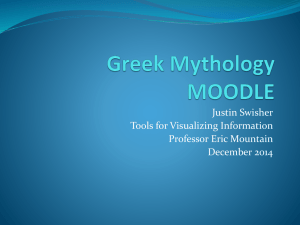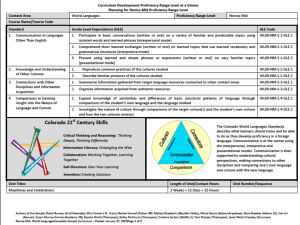Early Human Origin and Migration
advertisement
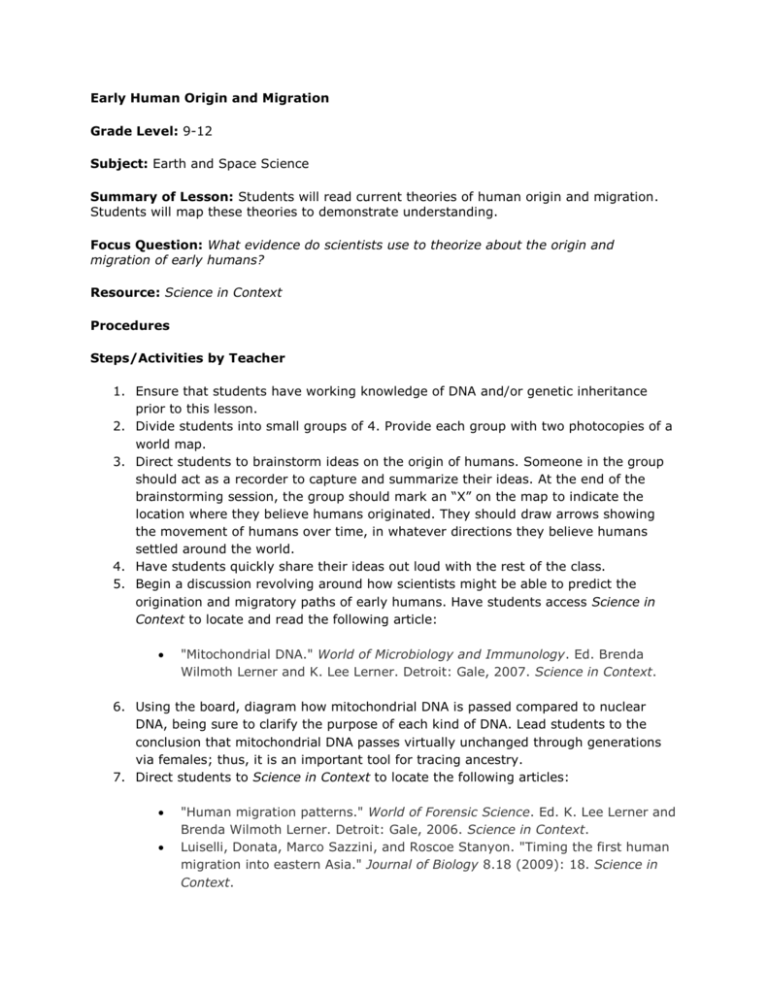
Early Human Origin and Migration Grade Level: 9-12 Subject: Earth and Space Science Summary of Lesson: Students will read current theories of human origin and migration. Students will map these theories to demonstrate understanding. Focus Question: What evidence do scientists use to theorize about the origin and migration of early humans? Resource: Science in Context Procedures Steps/Activities by Teacher 1. Ensure that students have working knowledge of DNA and/or genetic inheritance prior to this lesson. 2. Divide students into small groups of 4. Provide each group with two photocopies of a world map. 3. Direct students to brainstorm ideas on the origin of humans. Someone in the group should act as a recorder to capture and summarize their ideas. At the end of the brainstorming session, the group should mark an “X” on the map to indicate the location where they believe humans originated. They should draw arrows showing the movement of humans over time, in whatever directions they believe humans settled around the world. 4. Have students quickly share their ideas out loud with the rest of the class. 5. Begin a discussion revolving around how scientists might be able to predict the origination and migratory paths of early humans. Have students access Science in Context to locate and read the following article: "Mitochondrial DNA." World of Microbiology and Immunology. Ed. Brenda Wilmoth Lerner and K. Lee Lerner. Detroit: Gale, 2007. Science in Context. 6. Using the board, diagram how mitochondrial DNA is passed compared to nuclear DNA, being sure to clarify the purpose of each kind of DNA. Lead students to the conclusion that mitochondrial DNA passes virtually unchanged through generations via females; thus, it is an important tool for tracing ancestry. 7. Direct students to Science in Context to locate the following articles: "Human migration patterns." World of Forensic Science. Ed. K. Lee Lerner and Brenda Wilmoth Lerner. Detroit: Gale, 2006. Science in Context. Luiselli, Donata, Marco Sazzini, and Roscoe Stanyon. "Timing the first human migration into eastern Asia." Journal of Biology 8.18 (2009): 18. Science in Context. Wade, Nicholas. "DNA Study Yields Clues on First Migration of Early Humans." New York Times 13 May 2005: A8(L). Science in Context. Bower, Bruce. "Mongolian skeleton, western man: 2,000-year-old DNA suggests early Indo-European migration." Science News 27 Feb. 2010: 14. Science in Context. 8. Instruct students to divide the articles among the group. Each group member should read, highlight, and notate their article, and should be prepared to share their evidence on the migration of humans. 9. After the groups have had ample time to review notes and discuss their articles, instruct them to pull all of the evidence together on their unused world map. Direct them to piece together a new map showing the migratory path of early humans based on the scientific evidence provided in the articles. As before, they should mark humanity’s location of origin with an “X” and use arrows to show migration patterns. Students should use color, labels, and/or a key to provide explanatory detail. 10. Instruct the groups to write a brief summary that synthesizes current evidence about the origin and movement of early humans. Part of this summary should address the physical differences among people despite origination in similar ancestry. 11. Post the maps and paragraphs and have the groups share their findings. Steps/Activities by Students 1. With your group, brainstorm ideas about the origin of humans. Identify a group member to act as recorder to capture and summarize all ideas. 2. At the end of the brainstorming session, mark an “X” on one copy of the world map to indicate the location where your group feels humans originated. Draw arrows showing the movement of humans over time, in whatever direction(s) you feel humans settled around the world. Share these ideas out loud. 3. Participate in the discussion on scientific methods used to predict the origination and migratory paths of early humans. Access Science in Context to locate and read the following article: "Mitochondrial DNA." World of Microbiology and Immunology. Ed. Brenda Wilmoth Lerner and K. Lee Lerner. Detroit: Gale, 2007. Science in Context. 4. After a discussion of mitochondrial and nuclear DNA, access Science in Context to locate the following articles: "Human migration patterns." World of Forensic Science. Ed. K. Lee Lerner and Brenda Wilmoth Lerner. Detroit: Gale, 2006. Science in Context. Luiselli, Donata, Marco Sazzini, and Roscoe Stanyon. "Timing the first human migration into eastern Asia." Journal of Biology 8.18 (2009): 18. Science in Context. Wade, Nicholas. "DNA Study Yields Clues on First Migration of Early Humans." New York Times 13 May 2005: A8(L). Science in Context. Bower, Bruce. "Mongolian skeleton, western man: 2,000-year-old DNA suggests early Indo-European migration." Science News 27 Feb. 2010: 14. Science in Context. 5. Divide the articles among the group. Each group member should read, highlight, and notate an article, and should be prepared to share their evidence on the migration of humans. 6. Review notes and discuss among your group. Use the evidence from your articles to mark up the second copy of the world map. As before, mark humanity’s location of origin with an “X” and use arrows to show migration patterns. Use color, labels, and/or a key to provide explanatory detail. 7. As a group, write a brief summary synthesizing current evidence about the origin and movement of early humans. Part of your summary should address the physical differences among people despite origination in similar ancestry. 8. Share your findings as directed. Related Activities Science Students research the different branches of humankind and changes to physical appearance over time. Social Studies Use this lesson as a springboard for a discussion of global tolerance and the idea that humans are the same despite appearances and what people are taught to believe. Content Standards Next Generation Science Standards LS4.D:1. Biodiversity is increased by the formation of new species (speciation) and decreased by the loss of species (extinction). (secondary to HS-LS2-7) HS-LS4-1. Communicate scientific information that common ancestry and biological evolution are supported by multiple lines of empirical evidence. HS-LS4.CC.1.1. Different patterns may be observed at each of the scales at which a system is studied and can provide evidence for causality in explanations of phenomena. (HS-LS41), (HS-LS4-3) HS-ESS2.CNS.1.3. Science includes the process of coordinating patterns of evidence with current theory. (HS-ESS2-3) Standards Source: Next Generation Science Standards (2013) Common Core State Standards Grades 9-10 CCSS.ELA-Literacy.RST.9-10.2 Determine the central ideas or conclusions of a text; trace the text's explanation or depiction of a complex process, phenomenon, or concept; provide an accurate summary of the text. CCSS.ELA-Literacy.RST.9-10.4 Determine the meaning of symbols, key terms, and other domain-specific words and phrases as they are used in a specific scientific or technical context relevant to grades 9-10 texts and topics. CCSS.ELA-Literacy.RST.9-10.5 Analyze the structure of the relationships among concepts in a text, including relationships among key terms (e.g., force, friction, reaction force, energy). CCSS.ELA-Literacy.RST.9-10.9 Compare and contrast findings presented in a text to those from other sources (including their own experiments), noting when the findings support or contradict previous explanations or accounts. CCSS.ELA-Literacy.RST.9-10.10 By the end of grade 10, read and comprehend science/technical texts in the grades 9-10 text complexity band independently and proficiently. CCSS.ELA-Literacy.WHST.9-10.4 Produce clear and coherent writing in which the development, organization, and style are appropriate to task, purpose, and audience. Grades 11-12 CCSS.ELA-Literacy.RST.11-12.2 Determine the central ideas or conclusions of a text; summarize complex concepts, processes, or information presented in a text by paraphrasing them in simpler but still accurate terms. CCSS.ELA-Literacy.RST.11-12.4 Determine the meaning of symbols, key terms, and other domain-specific words and phrases as they are used in a specific scientific or technical context relevant to grades 11-12 texts and topics. CCSS.ELA-Literacy.RST.11-12.5 Analyze how the text structures information or ideas into categories or hierarchies, demonstrating understanding of the information or ideas. CCSS.ELA-Literacy.RST.11-12.8 Evaluate the hypotheses, data, analysis, and conclusions in a science or technical text, verifying the data when possible and corroborating or challenging conclusions with other sources of information. CCSS.ELA-Literacy.RST.11-12.9 Synthesize information from a range of sources (e.g., texts, experiments, simulations) into a coherent understanding of a process, phenomenon, or concept, resolving conflicting information when possible. CCSS.ELA-Literacy.RST.11-12.10 By the end of grade 12, read and comprehend science/technical texts in the grades 11-12 text complexity band independently and proficiently. CCSS.ELA-Literacy.WHST.11-12.4 Produce clear and coherent writing in which the development, organization, and style are appropriate to task, purpose, and audience. Standards Source: Common Core State Standards Initiative (2010)

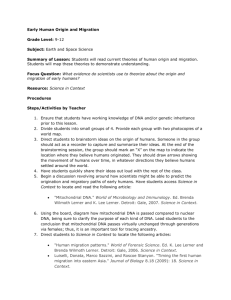
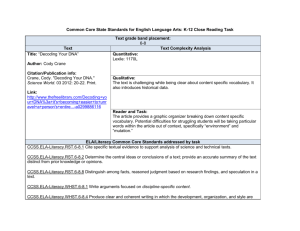


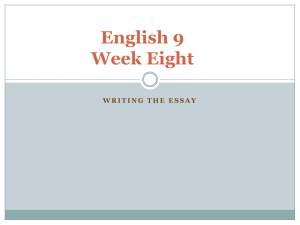
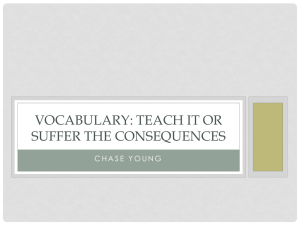
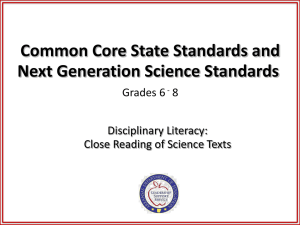
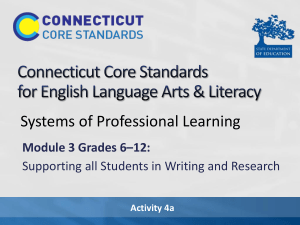
![iPads_and_Writing_2013[1]](http://s2.studylib.net/store/data/005383991_1-1bc8c0f2382c2ccb89e094c534f531f0-300x300.png)
